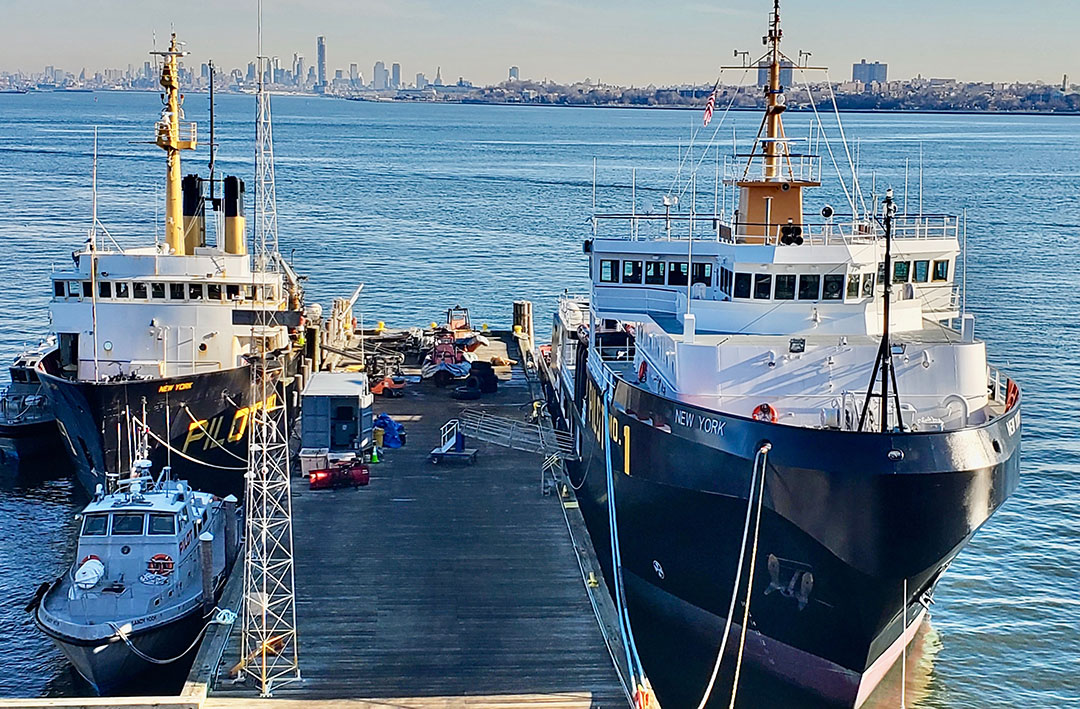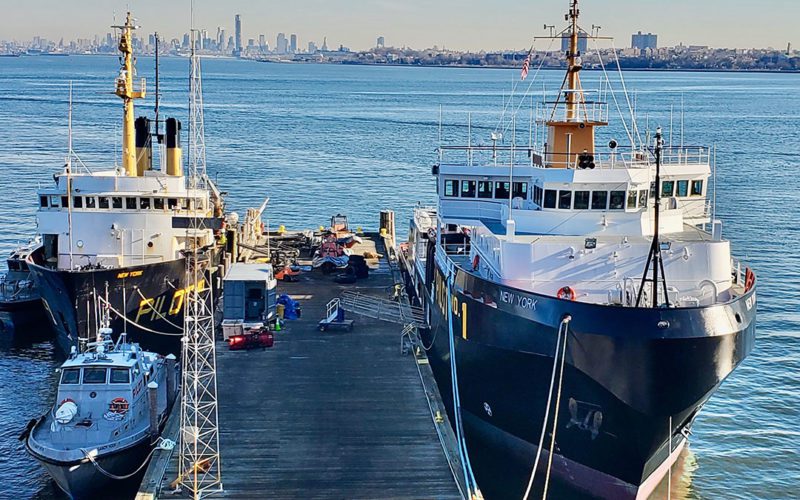
The Sandy Hook Pilots Association has put its new station boat into service at the entrance to New York Harbor.
The 208-foot New York is larger and has an improved seakeeping ability than the 137-foot New Jersey and its predecessor, the 182-foot New York. It has a fully staffed mess, pilot lounge and berthing for 28 pilots in 14 staterooms.
“Our other station boats, the former New York and the New Jersey, had to come in every three weeks for fuel and water,” said Capt. John DeCruz, president of the New York Sandy Hook Pilots. “This boat can stay out six weeks and possibly longer.”
The Sandy Hook Pilots are the lone pilot group in the United States that still use a large station boat. New York and New Jersey operate around the clock every day of the year underway or at anchor between Sandy Hook, N.J., and Long Beach, N.Y., with a permanent 12-person crew.
The station boat serves as a home base for pilots after they disembark outgoing ships and await their next inbound assignment, saving time and reducing runs on the group’s four pilot launches. New York is typically used during the colder months, and New Jersey is used during the summer.
The Sandy Hook Pilots acquired the new New York almost four years ago. The former Maine Responder, it was based in Portland, Maine, for Marine Spill Response Corp. The vessel was laid up when the pilots bought it, and it was subsequently towed to New York.
JMS Naval Architects of Mystic, Conn., was hired to help redesign the vessel from an oil spill response ship into a pilot station boat. The work proceeded in three phases.
Phase one consisted of a hull inspection, dropped rudders, shaft inspection and a complete modification of the stern, readjustment of mast and observation tower, and the development of anchor pockets. There was also an initial inspection and project approvals from the American Bureau of Shipping and the Coast Guard.
Phase one took place at Caddell Dry Dock and Repair Co. of Staten Island, N.Y. The final two phases were completed at Feeney Enterprises in Kingston, N.Y. New potable water tanks capable of holding 60,000 gallons were added to extend the ship’s duration at sea. A two-story deckhouse with the pilot berthing, lounge and mess area also was added to the existing house.
“The major conversion primarily involved removing the original oil recovery equipment, modifying tankage and adding a large deckhouse for the pilot accommodations,” said Blake Powell, president of JMS. “The fuel and water capacity were increased in order to extend the time the vessel can remain on station.”
Naval architects also focused on ensuring pilots could safely board the vessel in challenging sea conditions, he added. The design modified the pilot boarding area and extended the bridge wings to ensure a clear view of the pilot launch landing area on each side of the vessel. It also added a de-icing system at the boarding area and a Dacon man-overboard rescue system.
There are about 65 pilots in the Sandy Hook group, and a typical day often starts with a pilot boarding an outbound ship at one of the New York-area terminals. They disembark as the ship passes the station boat and then wait for their next inbound job. That wait can vary from an hour or two to six or eight. That puts a premium on pilot comfort.
“We have a full steward department with a cook and two stewards, and meals and refreshments are available 24/7,” DeCruz said. “You can sleep or lay down and read a book or watch TV. You’ve got everything you need as if you were at home while you’re waiting for your next job.”
New York is powered by twin Caterpillar 3512 engines, along with a Cat 3408 engine driving a Schottel bow thruster. Both mains have about 9,000 hours on them, and they were overhauled shortly before the Sandy Hook Pilots acquired the ship.
New York sailed to its new home at the Sandy Hook Pilots base in Staten Island on Feb. 3. The crew of apprentice pilots and permanent union crew from the International Organization of Masters, Mates & Pilots spent six weeks familiarizing themselves with the vessel and participating in training conducted by Maritime Pilots Institute of Covington, La.
Its maiden voyage came on March 23 following a blessing at the Sandy Hook Pilots’ pier. From there, New York sailed to the pilot station where it remained as of press time. •

